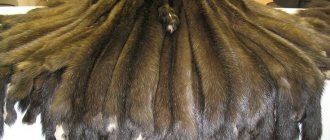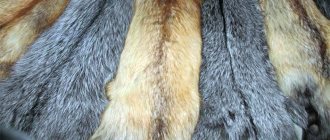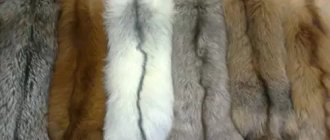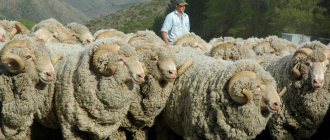Evgeny Shvarts City December 12, 2019
We continue our review of iconic buildings for the city that have lost their old functions, but have taken too long to be rebuilt for a new purpose. “A palace abandoned to oblivion,” Pushkin once described the Mikhailovsky Castle. This definition is quite suitable for the Fur House at 98 Moskovsky Prospekt, although it is a monument of a much later era. For its majestic monumentalism, the townspeople colloquially call the House of Furs a “palace.”
Once upon a time, the building on Moskovsky embodied the sovereign image of Soviet foreign trade. Now it is a regular business center. PHOTO by Dmitry SOKOLOV
Soft gold
The sale of furs for the Soviet state in the first decades of its existence was one of the most important ways of receiving foreign currency - the era of oil and gas pipelines came much later. Modern synthetic materials, which are more convenient and cheaper for sewing clothes than natural ones, have not yet been invented. Animal rights activists have not yet set trends. So the skins of sables, minks and arctic foxes, both wild and raised on animal farms, brought a stable income to the USSR treasury.
In 1931, the foreign economic association “Soyuzpushnina” was created. It was decided to hold the auction of skins in Leningrad. The order to construct a building for him on Mezhdunarodny (as Moskovsky was then called) Avenue was signed in December 1936. Construction and design took only two years (a period that is difficult to meet even with today’s technologies, but the importance of the object apparently dictated it). The house opened its doors in 1939.
In the same year, in No. 1 of the magazine “Architecture of Leningrad”, a critic wrote about the new house: “The author of the project is Prof. D. F. Fridman (5th design workshop of the Moscow City Council). The work was carried out by the Lentorgstroy trust with the participation of the Gosotdelstroy office.
In plan, the Fur House has a clear axial design, which is also expressed on the main façade. At the same time, the central front part, the main entrance and portico of the facade, corresponds to a large semi-circular auction hall located on the same central axis, and the two symmetrically located eight-column Corinthian order wings of the facade correspond to four floor pairs of operating rooms and exhibition halls.”
.
Palace of international scope
“When a visitor enters the building, he first finds himself in a spacious, bright lobby-wardrobe with an area of about 500 square meters. meters,
- noted contemporaries.
“ Its floors were paved with marble slabs, and the ceiling was supported by six pairs of Doric columns, decorated with artificial marble and decorated with capitals decorated with Ionic ...”
Related article:
Where will the Seagull fly? The former cinema building in Lisy Nos is up for auction
The critic noted that the halls are connected by lifts and stairs to the basement, where refrigerated warehouses are located (fur storage requires an average temperature of 4 degrees). The rich street facade of the building, decorated with a well-drawn central portico and 16 Corinthian order columns, is finished with marble chips with mica plates embedded in its thickness.
“The latter give a pleasant shine in sunlight and enliven the matte gray texture of the facade. Speaking about the external architectural forms of the House of Furs as a whole, it would be easiest to blame the author for an uncritical mastery of classical forms and an excessive passion for decoration. However, this is not entirely true, since in the interpretation of the cornice, which has a 2-meter extension and is decorated with heavy modillions, and in the rhythm of heavy balconies, and in the successful combination of a high, smooth attic with an elegant colonnade, and in the design of the ends, the entire tested arsenal of old classical forms by the author applied in a rather new and tasteful way"
. True, the author noted that a building of this appearance would look better in a square or closing off the perspective of the street.
It can be added that the major Soviet architect Daniil Fridman worked mainly in Moscow (his main buildings were the People's Commissariat of Defense Industry, Substation 1 of the Moscow Metro, as well as the Central Department Store in Kiev), the Fur House was his only building in Leningrad. Modern critics call this building an example of Stalinist neoclassicism.
Hammer and Hammer
At the beginning of this century, I still managed to visit the house when it was used for its original purpose. He even published correspondence from the auction in St. Petersburg Gazette. In front of them, professional dealers examined the skins and noted which batch of goods was especially interesting to them. There was a slight smell of furs in the corridors ( “Sable smells like sable”
, they told me then) and... a lot of money. The fur auction itself was conducted using ancient technology: “by voice.” There was a kind of romance, vintage. On stock and currency exchanges, prices have long been set on a computer...
But the auctioneer's hammer gave way to the builder's hammer. In July 2014, major renovations began in the building; it was announced that instead of fur auctions, a bank office would appear here. The interested party was a commercial bank. The renovation was supposed to be completed in 2021. But the building, apparently, is not used by clerks. Outwardly it gives the impression of being empty.
The group of companies themselves responded to my request that they are not currently working at this address, so they do not comment on the fate of the house. The press service of the commercial bank responded to the editor’s request that this credit institution “does not plan to move to the Fur Palace”
.
According to www.kartoteka.ru, JSC Soyuzpushnina has a legal address in Moscow (OSP is, as we understand, a separate division), the authorized capital of the company is 4.25 million rubles. According to www.kartoteka.ru, OJSC “Fur House” has an authorized capital of 8.23 million rubles. The company is registered in Moscow (legal address), and the St. Petersburg Fur House is listed as a branch.
Judging by the report on the results of 2021, all the activities of the Fur House were reduced to work on the reconstruction of the building at 98B Moskovsky Avenue, which is owned by the company.
It is still unknown who will move into the house on Moskovsky and when.
#historical buildings #architecture #city history
The material was published in the newspaper “St. Petersburg Vedomosti” No. 234 (6587) dated December 12, 2019 under the title “Skins to the side.”
Share on VKontakte Facebook
Cool
Secret sable: about fur matters in the country
— The Russian Fur Union (hereinafter referred to as the Union. — Ed.) can’t exist without hunters, and hunters can’t live without you. You are the logical conclusion of the chain “fur - hunter - consumer”.
— Yes, the Union unites about 70 large legal entities that represent all sectors of the country’s fur industry. The interests of commercial hunters are represented by large companies that supply sable to Soyuzpushnina auctions.
In addition, the Union includes large fur farms that specialize in breeding caged sable, research institutes dealing with specialized issues, and enterprises associated with processing skins and sewing fur products, as well as trade organizations that sell finished products. Our organization turns 20 this year.
— What is the history of the Union? Was it created as someone’s personal initiative or was it a requirement of the time?
— Probably the requirement of the time. The initiators were people who are no longer alive: Ildar Abdulovich Akkhuzin, Viktor Grigorievich Chipurnoy, Anatoly Lazarevich Zhemchuzhin and other famous people who were not indifferent to the fate and future development of the fur industry.
We registered in 1997, and already in 1998 the Union was accepted into the International Fur Federation (IFF), which consists of 45 states. At that time, the interests of Russia in the international arena were represented by Soyuzpushnina.
Read the material “Sable and fur coat: a history of deception”
She, by the way, was one of the organizers of this international federation back in 1949. But the USSR collapsed, and our Union was accepted from Russia into the federation, while the “Soyuzpushnina” retained its membership. The President of the Union is a member of the MMF board.
In addition, on the basis of the Union, three years ago a regional branch of the IMF “Eurasia” was organized, which included Russia, Ukraine, Belarus, Kazakhstan and Turkey. The next step is the accession of Uzbekistan.
— Did they have to be convinced to unite or did they agree of their own free will?
— There was a desire from large enterprises that faced high competition from foreign fur producers.
For example, Greece, China and other large clothing manufacturers came to our market, but we were not ready to fight with importers who were not always conscientious. We needed to protect our interests at the federal level.
Read the material “Humane traps: for or against”
It was impossible to resolve all issues without a direct conversation with the government. Therefore, we united consciously. In total there were 17 founders - large fur industry enterprises and specialized fur farms, which created the Union.
| Today, squirrel and muskrat are hunted only as companion species. For comparison: mink sells for 30–50 euros, and squirrel for 3–5 euros. |
Its tasks are to support and develop the industry, protect common interests, legislate, i.e. global issues. In recent years, hunting users have actively begun to join us. They probably saw that we were doing real work. Previously there were only a few of them.
— At what level are hunting users represented?
— At the level of large fur suppliers. These are representatives of the Far Eastern and Siberian regions, companies that have long-term leases of thousands of hectares of hunting grounds and are suppliers of 10, or even 50 thousand sables for auction.
— The Union holds any events?
— In 2014, in Krasnoyarsk we held the next forum of the Union on hunting topics. At that time, the issues of redistribution of the fur market and the sale of sables were acute. Based on the results of the forum, a common position of the participants was developed, aimed at improving the current mechanism for the circulation of sable and brought to the attention of the Government of the Russian Federation.
The previously existing doctrine provided that about 90% of furs were sold through Soyuzfur auctions. Auctions are a form of fur trading that is accepted throughout the world and has been practiced for decades. Of the five major international auctions, St. Petersburg stands apart: it specializes in sable.
News on the topic : “The Ministry of Natural Resources of the Russian Federation proposed to ban the circulation of sable skins without special markings”
There are Scandinavian auctions (Copenhagen and Helsinki) that specialize in mink and cage furs, and there is an auction in Toronto that also sells hunting furs. And in all countries producing caged and commercial furs, at least 90% of skins are sold through auctions.
In the 90s, when new “owners” appeared, many people thought: can’t we sell our sables ourselves? As a result, some went with their sables to Copenhagen, and some flew to Seattle. But, as a rule, their furs were sold at a lower price, and practically no money made it into the Russian budget.
As a result, the sable market was taken away piece by piece, and we did not know what the actual turnover of sable was in the country. In the early 2000s, with the arrival of the new management of Soyuzpushnina, it was possible to consolidate the supply and sale of sable so that until recently, 100% of the sable that went for sale (including for export) was sold only through the Soyuzpushnina auction. .
This is what they talked about in Krasnoyarsk - about the past and future of the industry. This year we held a similar forum in Irkutsk.
— Who and at what level promoted the idea of a regional platform for the sale of sable in Irkutsk?
“A legal, transparent system has long been established that allows us to attract buyers from all over the world to the auction and receive maximum prices for the furs exhibited. In our opinion, real competition is competition between buyers for goods, and not between sellers for buyers.
Read the material “ZMU: an all-Russian setup”
It’s right when a hundred buyers come from all over the world and everyone needs to buy a certain amount of the required quality of sables. And they know that if they don’t buy here, they won’t buy anywhere at all. This is how it should be! But for some reason the idea of creating your own auction seemed very attractive to regional leaders.
True, they said, provided that the state budget provides money. They named numbers: 100, 200 million rubles. I still can’t understand why it is necessary to spend budget money, break the existing trading system, and disorient buyers.
| Lot of wild sable at the Soyuzfur auction. |
The results of the first Baikal auction clearly showed that sable hunters lost 10–15% of the price of sable this season. Buyers did not hide the fact that they would come to Irkutsk for high-quality fur only at a lower price. Auction trading is a subtle and delicate business that does not tolerate improvisation.
— What is the future of the Baikal auction? At the level of regional elites, the future may seem promising, but at the level of the country’s leadership...
“I think that now not everyone finds the auction trade in sable an exciting and very profitable business. The creation of regional platforms is harmful, but they are not prohibited by law. If you want to hold your own auction, do it! But what is the goal?
As we found out in private conversations with the organizers of this event in Irkutsk, one of the motives for organizing the Baikal auction was a certain offense: someone once offended someone in St. Petersburg when selling his sables. Well, if this is considered a sufficient reason to organize such a serious event...
Read the material “Who buys Russian sable”
In my opinion, the Baikal auction and other regional platforms have no prospects and should not have them. To continue the dangerous experiment, the participation of budgets, including regional ones, is required.
The leadership of the Irkutsk region has already thought about how expedient it is to support this event, since it brought practically nothing to the region’s budget.
If resident furs were sold in Irkutsk, the budget would receive significant funds from tax revenues at all levels, and since Magadan and Kamchatka sables were sold, the budget would only receive taxes from commission transactions, and this is clearly not the money that was promised.
Today, the authority of the St. Petersburg auction has become even higher, and in the coming decades it will probably not be possible to beat it. This requires enormous money and reputation. This could not be done in the late 90s, when, in defiance of the Leningrad auction, they wanted to create a Moscow fur auction.
There was even an order from Prime Minister V.S. Chernomyrdin on the issue of its financing. They brought in members of the government, Moscow Mayor Yu.M. Luzhkov, they planned to hold it right in the Kremlin. But despite such efforts and budget help, the auction failed. The fur harvesters did not bring the furs, and the buyers did not come.
— The example of Moscow is not as alarming to me as the example of the Baikal auction. There are many savvy entrepreneurs across our country. After all, all this already happened in the 90s and ended with enterprising citizens selling primrose sable at international auctions for half the price for the “tail.” Today, despite this, we again see attempts at such an initiative.
- Agree. Deliveries to Copenhagen began with 120 thousand sable skins, but it all ended naturally. Because the price has collapsed. Everyone knew that they went to Copenhagen for mink, the trade of which there is from 14 to 17 million a year. Any batch of sable is a by-product.
The buyer was ready to take the sable at a price that was favorable to him. Because it is impossible to form full-fledged lots from small lots. Especially if we talk about gray sable. There is always little of it, and in order to collect a lot of gray sable, you need to attract several ridges. Then you can get the highest price for it.
Read the material “How to stand up for your hunting and natural resources”
The highest prices go to lots that are uniform in color, quality and fur structure, and this requires very large amounts of raw materials concentrated in one place. To create a full-fledged auction, it is necessary to start trading with at least 100-150 thousand skins.
At Soyuzpushnina auctions, anyone can see online what volumes of pelts are being sold and at what price. Everything is extremely open and clear. Do you know why the idea with Irkutsk came up?
Interest in the “pocket” site arose at the peak of fur prices in 2014–2015, when 700 thousand sable skins were traded with an average annual turnover of 400–450 thousand. Colossal turnovers! Everyone was fussing and running around, so someone wanted to make some money.
— In your opinion, is there any illegal hunting of sable?
— The auction is sometimes accused of selling illegally harvested furs and promoting overfishing. However, quotas for sable production are allocated to subjects by the state, based on accounting data obtained unclearly how and when, and which have not changed for many years.
Naturally, they do not always coincide with the volume of sables sold at auction. This happens mainly due to the free production of sable by indigenous peoples of the North (INN). This is where there is scope for all sorts of resellers and speculators.
We urgently need to regulate the norms for sable hunting by indigenous peoples, but we are told that by doing this we will infringe on their rights. Absurd!
Read the material “Commercial hunting during the war”
The thesis about the predatory production of sable in the country is also interesting. According to experts, harvesters, fishers and suppliers, this valuable species is underharvested.
In Soviet times, a hunter was thrown into the deepest wilderness by helicopter, but now he is thrown into the taiga at his own expense. That’s why it hunts closer to housing, roads, and rivers. And in remote areas of the taiga, sable breeds freely and during migrations descends to easily accessible places.
| Lot of gray sable at the Soyuzpushnina auction. |
Today, oddly enough, the market itself regulates production. There is a high price for sable - everyone went to the taiga, even the lazy one. The price dropped by half - the next year only 400 thousand “tails” were sold.
The hunter sits at home and watches how sable is traded and whether it makes sense to go to the taiga. In St. Petersburg, two wild sable auctions are held: in January and April. If in January it was sold at a high price, everyone immediately runs to the taiga to get something for the April auction.
Yes, we had years when sable was hunted too actively and a ban was introduced on its hunting. Today there is no such danger. The fact that from year to year the number of skins sold at auction exceeds the quota for its production does not mean that sable is being destroyed, but that the state should do something with the quotas.
We generally raise the issue of abolishing quotas and propose issuing permits based on production. The hunter left the taiga and immediately purchased permission for as many sables as he had caught. How else?
He doesn’t know how many animals will fall into his hundred traps: 50, 20 or 10. If he bought a permit to catch 30, but got 50 sables, is he already a criminal and should throw the sables out of the traps?
“The hunter, of course, will not throw away the caught animals, but will sell them to a dealer, and he will use them for the caught indigenous peoples.” Are you working with the Department of Hunting of the Russian Ministry of Natural Resources on this issue?
- Yes. I believe that the Ministry of Natural Resources should be a defender of promoting the interests of fishers and suppliers. On issues related to the circulation of sable, we were received by Minister S.E. Donskoy. He had to explain the groundlessness of the accusations against the Soyuzpushnina auctions of illegal trade in furs. We think he understood us correctly.
- Do you know what worries me? Near China; they will find some stubborn Chinese who wants to actively participate in the division of the world sable trade market, and the idea “we can do it ourselves” will arise again.
— It’s difficult with China. They have a ban on the production of sable in the country and the import of unprocessed fur of this type. Sable is purchased only through intermediaries, and they can only import semi-finished or finished products. This is done in order to discourage poaching.
For example. In 1991, the Chinese produced 700 thousand heads of caged mink, and in 2014 - almost 80 million. Since 2002, I have been fighting for a ban on the export of live sables (both caged and wild) outside the Russian Federation. There have been attempts by China, Scandinavian countries and the USA to obtain caged sable stock. It was very difficult to take out the savage, so they aimed at the caged sable.
Read the material “How will we extract fur?”
At that time, we had 10 sable breeding enterprises, and we managed to agree with the directors of the old school not to sell a single live animal abroad. Everyone understood that if we released sable to China, then in 10–15 years we could forget about the monopoly on it and the national heritage.
However, only in 2021 did the state decide to ban the export of live sables from the territory of the Eurasian Economic Union.
— Is this at the level of the law?
— This is the decision of the Eurasian Economic Commission. Since 2002, when this process began, we have written to both the president and the prime ministers. They gave instructions to ministries and departments to resolve the issue positively.
Everyone was in favor, but no decision was made to ban the export of the country’s national heritage. And this is a treasure, because only in Russia has cage breeding of sable been mastered. In the 50s, at the Moscow Zoo, Professor Manteuffel received the first offspring from wild sables.
Read the material “Fur Season”
Its industrial breeding has begun, and today there is an industry program developed by the Union for the development of cellular sable breeding with production of up to 100 thousand per year by 2021. And, I must say, the mark of 65 thousand skins has been successfully reached.
But, unfortunately, government support for the program has ceased.
- Who are the leaders?
— Our leaders are old: Saltykovskoye and Pushkinskoye fur farms, farms in the Leningrad region. New enterprises have appeared in the Tver region, Krasnodar region, and Kostroma. This is a fairly profitable business.
More than 90% of the products are exported, so our task was to prevent the sale of sables even to our closest neighbors. It is well known what will happen tomorrow if the sale of caged sables is allowed.
In the 90s, caged animals from the Leningrad region were sold to Latvia, and from Latvia they safely migrated to Scandinavia. To our delight, the Danes were not able to master the industrial breeding of sables. But the Chinese, I’m sure, would master it.
This is the situation in the market. I sometimes joke that in recent years our most important political animal is the sable!
After the bear, of course. No other type of game animal has been the subject of so many government orders and numerous interdepartmental meetings, usually in the DSP mode, like the sable, which has also turned it into a secret animal.
And as a result, many professional experts found themselves cut off from resolving specific issues related to the sable trade.
| Participants of the International Conference “Fur Trade in the 21st Century. Russia and the world." |
— The Russian Federation has ratified the Agreement on Humane Traps. But this is a blow to the hunter: traps are expensive and ineffective. Why was it not possible to resist this idea?
— Besides us, it was ratified by the European Union and Canada, and the Americans are present in this agreement as observers. If we had not signed and ratified the Agreement, the path of sable fur to international markets would have been closed.
— In fact, is this some kind of restrictive measure against the Russian fur producer?
- Yes. True, it seems to be part of the struggle for animal rights. Fortunately, we already have companies that produce these traps. The quality, according to hunters, is not very high, so their design needs to be improved. For these purposes, a trap certification center has been created at Tsentrokhotkontrol.
Read the material “Fuss around sables”
At every forum where the results of the implementation of this agreement by the participating countries are discussed, everyone wants to hear how humane traps are used in Russia... Recently it was decided that without certification of fur farms for compliance with international standards for raising fur-bearing animals, not a single skin will be produced after 2021 will not be included in the auction. And on time!
Last year, representatives of the Fendi trading house demanded that the Soyuzpushina auction issue certificates that the wild sable skins sold were obtained using humane traps, and the caged ones were grown under normal conditions of keeping and feeding. Since December last year, the auction began issuing such certificates to buyers of sable furs.
— Does the caged sable compete with the wild one?
— In terms of structure, size and quality, this is a different sable. Thanks to the selection of producers, the cells are larger and more uniform in color. It has a coarser hair structure and is used mainly for finishing products (sleeves, collars).
It has its own niche in the market, but it should not be produced more than 100 thousand per year, then it will be in demand. In the best times, wild sable was harvested at 600–700 thousand per year. In our opinion, the total quantity of both types of sable harvested per year should not exceed 900 thousand pieces.
— And in monetary terms?
— The price difference is 10–15%. The caged sable does not compete with the savage. But there is one more important point. Caged sable is a safety net in case the animal’s natural reserves are depleted due to fires, intensive logging, and floods. This is a resource for our descendants.
— Who is the main buyer of furs?
— If we talk about sable, then the Europeans, fashion houses from Italy and Greece. Americans buy quite a lot. Recently, the activity of buyers from China has increased: more than 70% of caged furs, mainly mink, go to this country.
| Organizers of the International Conference “Fur Trade in the 21st Century. Russia and the World": Ministry of Natural Resources and Environment of the Russian Federation with the support of the Russian Fur Union, auction, International Fur Federation (IFF). |
— Where is Russia in terms of total fur income?
— If in Soviet times any fur-bearing animal, starting with the gopher, hare, mole, was used for the production of fur products, today only the most valuable species are harvested - sable and marten.
In addition, the leading position in cellular furs has been lost. In 1991, the country produced approximately 30% of the world's fur production. Together with wild furs, they accounted for 35–40% of the world production of skins of fur-bearing animals. Today it is 3.5%.
Read the material “Fuss around sables (continued)”
In the USSR there were 586 enterprises that were engaged in the production of cellular furs. Today there are 32 farms left in Russia. Fur farming has been lost in Karelia, Primorye, Sakhalin, and Kamchatka. In Soviet times, funds for the purchase of breeding animals were registered in the USSR State Planning Committee as a separate line in the amount of 2 million foreign currency rubles.
This was colossal money at that time, which allowed us to concentrate in the country all the breeds and types of fur-bearing animals bred in the world.
— Does the industry still have problems?
- Of course there is! For example, the issue of restrictions on receiving cash was raised at the forum. Banks introduce them under the pretext of fighting terrorism. But what to do in the taiga with a credit card? How to pay a fur hunter? The hunter only wants cash, because as soon as he can buy food and fuel with it.
Read the material “The Problem of Russian Sable”
We addressed this issue to Minister S.E. Donskoy and the head of the Central Bank E. Nabiullina were asked to resolve this issue based on the specifics of the industry, because we are talking about payments for expensive products worth millions of rubles in remote and hard-to-reach regions of the country.
— Are you satisfied with today’s hunting legislation, since the law does not even say a word about commercial hunters? Should changes be made to the law that would regulate fur harvesting?
- I think this needs to be done. Hunters should be identified as a separate category of hunters, certain preferences should be provided, and the necessary conditions should be created for hunting users who are engaged in fur harvesting on a long-term basis.
It is also necessary to sort out the rights to unlimited hunting of the indigenous peoples of the north. I won’t go into depth, but many problems are associated with the law on indigenous minorities. It is necessary to improve its provisions.
Read the material “Putting your hands on the fur”
Everyone understands that fur hunting is a traditional activity for indigenous and small peoples. But it is necessary to establish fair standards for the production of animals and fish that every family needs to live.
— As far as I remember, there were such restrictions in the USSR.
- Were. But then the trade in fur was regulated by the state. Everything that was prepared was handed over to the state. Of course, even then there was leftist fur, but state control was very serious. And there were enough criminal cases.
—Are furriers being trained today?
- Hardly ever. Only the Moscow Veterinary Academy has preserved the Faculty of Commodity Science. Students undergo practical training at Soyuzpushnina auctions. The union helps them, finances their accommodation and travel.
The specialists who work at Soyuzpushnina today are all graduates of the Soviet Bottling Veterinary Academy.
The decline in the attractiveness of our industry is eloquently evidenced by the fact that in Soviet times the competition at the Moscow Veterinary Academy was 10 people per place and accepted 120 students. Now they can barely recruit 40 people.
Interviewed by Alexander Lisitsin September 28, 2021 at 12:15
Section materials
October 28, 15:27
4.5 billion rubles will be allocated for the restoration of St. Petersburg monumental houses
October 28, 11:03
Bolsheokhtinsky Bridge celebrates its 110th anniversary
October 27, 14:42
Part of our memory. History of the Big House on Liteiny
October 26, 15:11
Rescuers of antiquity. How volunteers help preserve historical monuments
October 22, 12:10
The winners of the Golden Trezzini architectural and design competition have been announced
Chinchilla skin - price
The average price of a chinchilla skin at world fur auctions is about $60. And the price for one skin in a finished product sold in a store sometimes reaches $250. Such high prices are due to the fact that it is sometimes impossible to take your eyes off products made from chinchilla fur. Therefore, an independently organized chinchilla farm or chinchilla nursery is a step towards a secure future. Moreover, breeding chinchillas is not a troublesome matter at all.
Chinchilla farming today, as well as in the coming decades, will remain a highly profitable business, since chinchilla fur is the most valuable and expensive fur in the world. That is why CHINCHILLA is the most suitable object for breeding and sale.











